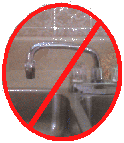 Why the Need?
Why the Need? Why the Need?
Why the Need?The market is flooded today with Drinking Water Systems offered by many companies large and small throughout the nation. With more than 500 companies selling water treatment products, it is easy to understand why consumers could have difficulty comparing one product to another. Most units improve only the water's taste and odor (aesthetics); the few units that do reduce contaminants of health concern very greatly in the range of contaminants that they effectively remove.
In recent years, industry standards have been established and widely accepted which make it much easier for the consumer to evaluate the many different systems available. This report will help you understand the standards and regulations which have been established nationally, and how consumers can compare water treatment devices currently on the market today.
The Federal Safe Drinking Water Act of 1974 established the U.S. Environmental Protection Agency as the agency responsible for setting standards for drinking water and monitoring the public water utilities. As of May, 1992, the EPA had established Federally enforceable standards for 89 contaminants that may be found in your drinking water. In a report commissioned by Ralph Nader, at least 2,110 contaminants have been identified in the nation's water supplies. The EPA will continue setting standards for additional contaminants but at a slower pace.
The standards established by the EPA are expressed as the "Maximum Contaminant Level" or "MCL" which represents the maximum level at which the contaminant can be found in your drinking water and the water still be considered "safe". Needless to say, drinking water that is considered "safe" today may not be considered "safe" tomorrow when new standards may be established. And "safe" may not meet your personal standards for healthy drinking water.
In addition, contaminants such as Lead, Trihalomethanes, and Asbestos, can occur in drinking water after the water leaves the water utility treatment plant. Lead is known to leach into water from the plumbing in our homes as well as from the municipal distribution system, causing problems for many water users. Even homes with copper plumbing can present a risk because until recently lead solder was used to connect the copper pipes.
Of equal concern is Trihalomethanes, an undesirable byproduct produced by chlorine treatment which is known to be a carcinogen. Disinfection is an essential component in the treatment of potable water, and chlorination has been used to make drinking water microbiologically safe in the United States since 1909. However, when chlorine is used for disinfection, there is cause for concern about the potential risks associated with Trihalomathanes and other disinfection byproducts that have been linked to cancer.
The EPA does not establish standards or testing protocol for drinking water treatment devices; the EPA refers consumers seeking assistance in evaluating water treatment devices to NSF International, and Underwriters Laboratories (UL), not-for-profit organizations devoted to developing and administering programs related to public health. NSF/ANSI standards and criteria are used internationally for consumer products and services, including drinking water treatment units. Widely recognized by public health officials as credible, third-party certifiers, NSF International and UL standards provide assurance to the consumer that the drinking water treatment devices certified by NSF or UL will perform in accordance with the claims made by the manufacturer or distributor.
In addition, some states have established certification or registration requirements for drinking water treatment devices for which health claims are made. To date, the States of California, Colorado, Iowa, Massachusetts, and Wisconsin have established some form of regulation for the point-of-use water treatment industry, and other state are soon to follow. As additional standards emerge nationally, it will be even easier for the consumer to compare water treatment devices.